Research on Long-Lived Room-Temperature Phosphorescence of Carbazole-Naphthalimide Polylactides
Abstract
1. Introduction
2. Experimental
2.1. Reagents and Instruments
2.2. Synthesis
2.2.1. Synthesis of 6-chloro-2-(9-ethyl-9H-carbazol-3-yl)-1H-benzo[de]isoquinoline-1,3(2H)-dione(A)
2.2.2. Synthesis of 2-butyl-6-chloro-1H-benzo[de]isoquinoline-1,3(2H)-dione(B)
2.2.3. Synthesis of 2-(9-ethyl-9H-carbazol-3-yl)-6-(2-hydroxyethoxy)-1H-benzo[de]isoquinoline-1,3(2H)-dione (CZ-NI-OH)
2.2.4. Synthesis of 2-(9-ethyl-9H-carbazol-3-yl)-6-((2-hydroxyethyl)thio)-1H-benzo[de]isoquinoline-1,3(2H)-dione (CZ-NI-SH)
2.2.5. Synthesis of 2-butyl-6-(2-hydroxyethoxy)-1H-benzo[de]isoquinoline-1,3(2H)-dione(NI-OH)
2.2.6. Synthesis of 2-butyl-6-((2-hydroxyethyl)thio)-1H-benzo[de]isoquinoline-1,3(2H)-dione(NI-SH)
2.2.7. Synthesis of PLAs
3. Result and Discussion
3.1. Characterization of Electrochemical Properties of Four Derivatives
3.2. Photoluminescence Properties of Polylactides
3.3. UV Absorption Properties of Polylactic Acid and Verification of Intramolecular Charge Transfer State
4. Conclusions
Author Contributions
Funding
Conflicts of Interest
References
- Yanai, N.; Kitayama, K.; Hijikata, Y.; Sato, H.; Matsuda, R.; Kubota, Y.; Takata, M.; Mizuno, M.; Uemura, T.; Kitagawa, S. Gas detection by structural variations of fluorescent guest molecules in a flexible porous coordination polymer. Nat. Mater. 2011, 10, 787–793. [Google Scholar] [CrossRef] [PubMed]
- Steinegger, A.; Klimant, I.; Borisov, S.M. Purely organic dyes with thermally activated delayed fluorescence—A versatile class of indicators for optical temperature sensing. Adv. Opt. Mater. 2017, 5, 1700372. [Google Scholar] [CrossRef]
- Miao, Q.; Pu, K. Organic Semiconducting Agents for Deep-Tissue Molecular Imaging: Second Near-Infrared Fluorescence, Self-Luminescence, and Photoacoustics. Adv. Mater. 2018, 30, 1801778. [Google Scholar] [CrossRef] [PubMed]
- Uoyama, H.; Goushi, K.; Shizu, K.; Nomura, H.; Adachi, C. Highly efficient organic light-emitting diodes from delayed fluorescence. Nature 2012, 492, 234–238. [Google Scholar] [CrossRef]
- Liu, Y.; Li, C.; Ren, Z.; Yan, S.; Bryce, M.R. All-organic thermally activated delayed fluorescence materials for organic light-emitting diodes. Nat. Rev. Mater. 2018, 3, 18020. [Google Scholar] [CrossRef]
- Cai, X.; Chen, D.; Gao, K.; Gan, L.; Yin, Q.; Qiao, Z.; Chen, Z.; Jiang, X.; Su, S.J. “Trade-Off” Hidden in Condensed State Solvation: Multiradiative Channels Design for Highly Efficient Solution-Processed Purely Organic Electroluminescence at High Brightness. Adv. Funct. Mater. 2018, 28, 1704927. [Google Scholar] [CrossRef]
- Shimada, M.; Yamanoi, Y.; Ohto, T.; Pham, S.T.; Yamada, R.; Tada, H.; Omoto, K.; Tashiro, S.; Shionoya, M.; Hattori, M.; et al. Multifunctional octamethyltetrasila[2.2]cyclophanes: Conformational variations, circularly polarized luminescence, and organic electroluminescence. J. Am. Chem. Soc. 2017, 139, 11214–11221. [Google Scholar] [CrossRef]
- Yang, Z.; Mao, Z.; Xie, Z.; Zhang, Y.; Liu, S.; Zhao, J.; Xu, J.; Chi, Z.; Aldred, M.P. Recent advances in organic thermally activated delayed fluorescence materials. Chem. Soc. Rev. 2017, 46, 915–1016. [Google Scholar] [CrossRef]
- Xiong, Y.; Zhao, Z.; Zhao, W.; Ma, H.; Peng, Q.; He, Z.; Zhang, X.; Chen, Y.; He, X.; Lam, J.W.Y. Designing Efficient and Ultralong Pure Organic Room-Temperature Phosphorescent Materials by Structural Isomerism. Angew. Chem. Int. Ed. 2018, 57, 7997–8001. [Google Scholar] [CrossRef]
- Ma, X.; Xu, C.; Wang, J.; Tian, H. Amorphous Pure Organic Polymers for Heavy-Atom-Free Efficient Room-Temperature Phosphorescence Emission. Angew. Chem. Int. Ed. 2018, 57, 10854–10858. [Google Scholar] [CrossRef]
- Wang, T.; Su, X.; Zhang, X.; Nie, X.; Huang, L.; Zhang, X.; Sun, X.; Luo, Y.; Zhang, G. Aggregation-Induced Dual-Phosphorescence from Organic Molecules for Nondoped Light-Emitting Diodes. Adv. Mater. 2019, 31, 1904273. [Google Scholar] [CrossRef] [PubMed]
- Mukherjee, S.; Thilagar, P. Recent advances in purely organic phosphorescent materials. Chem. Commun. 2015, 51, 10988–11003. [Google Scholar] [CrossRef] [PubMed]
- Yoshii, R.; Hirose, A.; Tanaka, K.; Chujo, Y. Functionalization of boron diiminates with unique optical properties: Multicolor tuning of crystallization-induced emission and introduction into the main chain of conjugated polymers. J. Am. Chem. Soc. 2014, 136, 18131–18139. [Google Scholar] [CrossRef] [PubMed]
- Yuan, W.Z.; Shen, X.Y.; Zhao, H.; Lam, J.W.Y.; Tang, L.; Lu, P.; Wang, C.; Liu, Y.; Wang, Z.; Zheng, Q. Crystallization-induced phosphorescence of pure organic luminogens at room temperature. J. Phys. Chem. C 2010, 114, 6090–6099. [Google Scholar] [CrossRef]
- Gong, Y.Y.; Tan, Y.Q.; Mei, J.; Zhang, Y.R.; Yuan, W.Z.; Zhang, Y.M.; Sun, J.Z.; Tang, B.Z. Room temperature phosphorescence from natural products: Crystallization matters. Sci. China Chem. 2013, 56, 1178–1182. [Google Scholar] [CrossRef]
- Gong, Y.; Zhao, L.; Peng, Q.; Fan, D.; Yuan, W.Z.; Zhang, Y.; Tang, B.Z. Crystallization-induced dual emission from metal-and heavy atom-free aromatic acids and esters. Chem. Sci. 2015, 6, 4438–4444. [Google Scholar] [CrossRef]
- Li, J.; Jiang, Y.; Cheng, J.; Zhang, Y.; Su, H.; Lam, J.W.Y.; Sung, H.H.Y.; Wong, K.S.; Kwok, H.S.; Tang, B.Z. Tuning the singlet-triplet energy gap of AIE luminogens: Crystallization-induced room temperature phosphorescence and delay fluorescence, tunable temperature response, highly efficient non-doped organic light-emitting diodes. Phys. Chem. Chem. Phys. 2015, 17, 1134–1141. [Google Scholar] [CrossRef]
- An, Z.; Zheng, C.; Tao, Y.; Chen, R.; Shi, H.; Chen, T.; Wang, Z.; Li, H.; Deng, R.; Liu, X. Stabilizing triplet excited states for ultralong organic phosphorescence. Nat. Mater. 2015, 14, 685. [Google Scholar] [CrossRef]
- Zhou, C.; Xie, T.; Zhou, R.; Trindle, C.O.; Tikman, Y.; Zhang, X.; Zhang, G. Waterborne polyurethanes with tunable fluorescence and room-temperature phosphorescence. ACS Appl. Mater. Interfaces 2015, 7, 17209–17216. [Google Scholar] [CrossRef]
- Zhang, G.; Chen, J.; Payne, S.J.; Kooi, S.E.; Demas, J.N.; Fraser, C.L. Multi-emissive difluoroboron dibenzoylmethane polylactide exhibiting intense fluorescence and oxygen-sensitive room-temperature phosphorescence. J. Am. Chem. Soc. 2007, 129, 8942–8943. [Google Scholar] [CrossRef]
- Chen, H.; Yao, X.; Ma, X.; Tian, H. Amorphous, Efficient, Room-Temperature Phosphorescent Metal-Free Polymers and Their Applications as Encryption Ink. Adv. Opt. Mater. 2016, 4, 1397–1401. [Google Scholar] [CrossRef]
- Zhou, Q.; Cao, B.; Zhu, C.; Xu, S.; Gong, Y.; Yuan, W.Z.; Zhang, Y. Clustering-triggered emission of nonconjugated polyacrylonitrile. Small 2016, 12, 6586–6592. [Google Scholar] [CrossRef] [PubMed]
- Gan, N.; Shi, H.; An, Z.; Huang, W. Recent Advances in Polymer-Based Metal-Free Room-Temperature Phosphorescent Materials. Adv. Funct. Mater. 2018, 28, 1802657. [Google Scholar] [CrossRef]
- Fateminia, S.M.A.; Mao, Z.; Xu, S.; Yang, Z.; Chi, Z.; Liu, B. Organic nanocrystals with bright red persistent room-temperature phosphorescence for biological applications. Angew. Chem. Int. Ed. 2017, 56, 12160–12164. [Google Scholar] [CrossRef] [PubMed]
- Köhler, A.; Bässler, H. Triplet states in organic semiconductors. Mater. Sci. Eng. R Rep. 2009, 66, 71–109. [Google Scholar] [CrossRef]
- Chen, X.; Xu, C.; Wang, T.; Zhou, C.; Du, J.; Wang, Z.; Xu, H.; Xie, T.; Bi, G.; Jiang, J. Versatile room-temperature-phosphorescent materials prepared from n-substituted naphthalimides: Emission enhancement and chemical conjugation. Angew. Chem. Int. Ed. 2016, 55, 9872–9876. [Google Scholar] [CrossRef]
- Wang, T.; Su, X.; Zhang, X.; Huang, W.; Huang, L.; Zhang, X.; Sun, X.; Luo, Y.; Zhang, G. A combinatory approach towards the design of organic polymer luminescent materials. J. Mater. Chem. C 2019, 7, 9917–9925. [Google Scholar] [CrossRef]
- Grabowski, Z.R.; Rotkiewicz, K.; Rettig, W. Structural changes accompanying intramolecular electron transfer: Focus on twisted intramolecular charge-transfer states and structures. Chem. Rev. 2003, 103, 3899–4032. [Google Scholar] [CrossRef]
- Iwata, S.; Tanaka, J.; Nagakura, S. Phosphorescence of the Charge-Transfer Triplet States of Some Molecular Complexes. J. Chem. Phys. 1967, 47, 2203–2209. [Google Scholar] [CrossRef]
- Dias, F.B.; Pollock, S.; Hedley, G.; Pålsson, L.; Monkman, A.; Perepichka, I.I.; Perepichka, I.F.; Tavasli, M.; Bryce, M.R. Intramolecular charge transfer assisted by conformational changes in the excited state of fluorene-dibenzothiophene-S, S-dioxide co-oligomers. J. Phys. Chem. B 2006, 110, 19329–19339. [Google Scholar] [CrossRef]
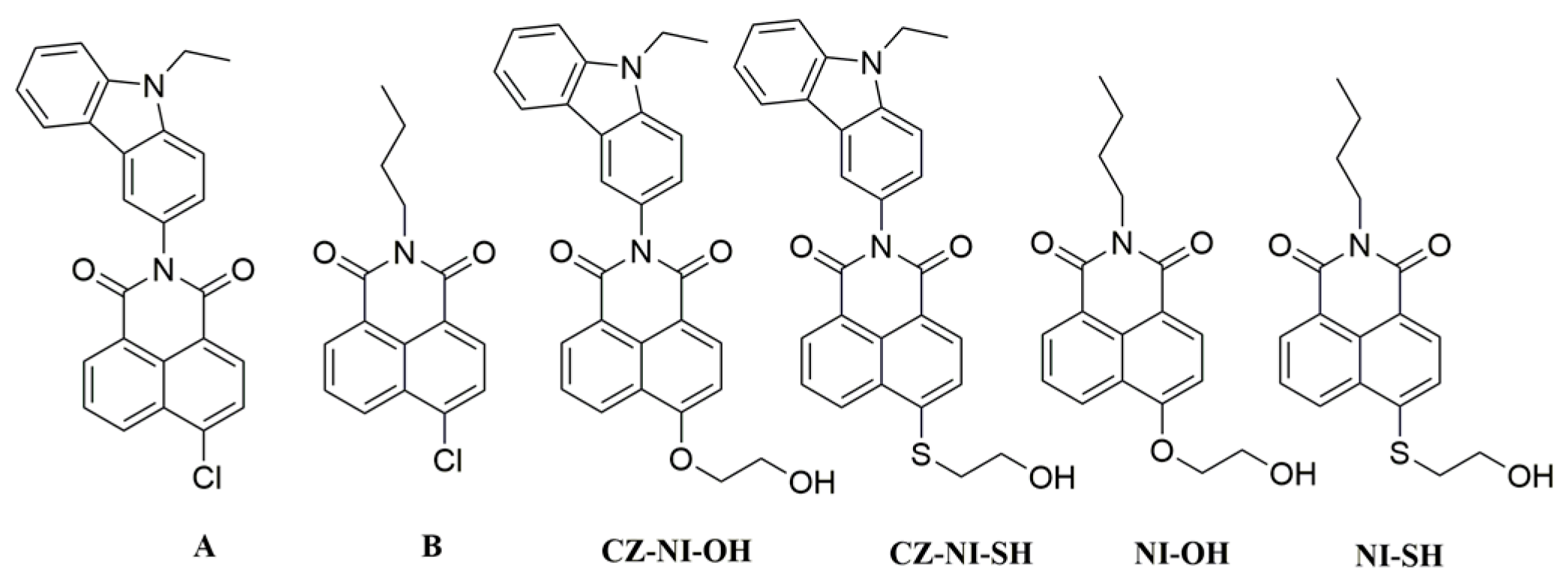

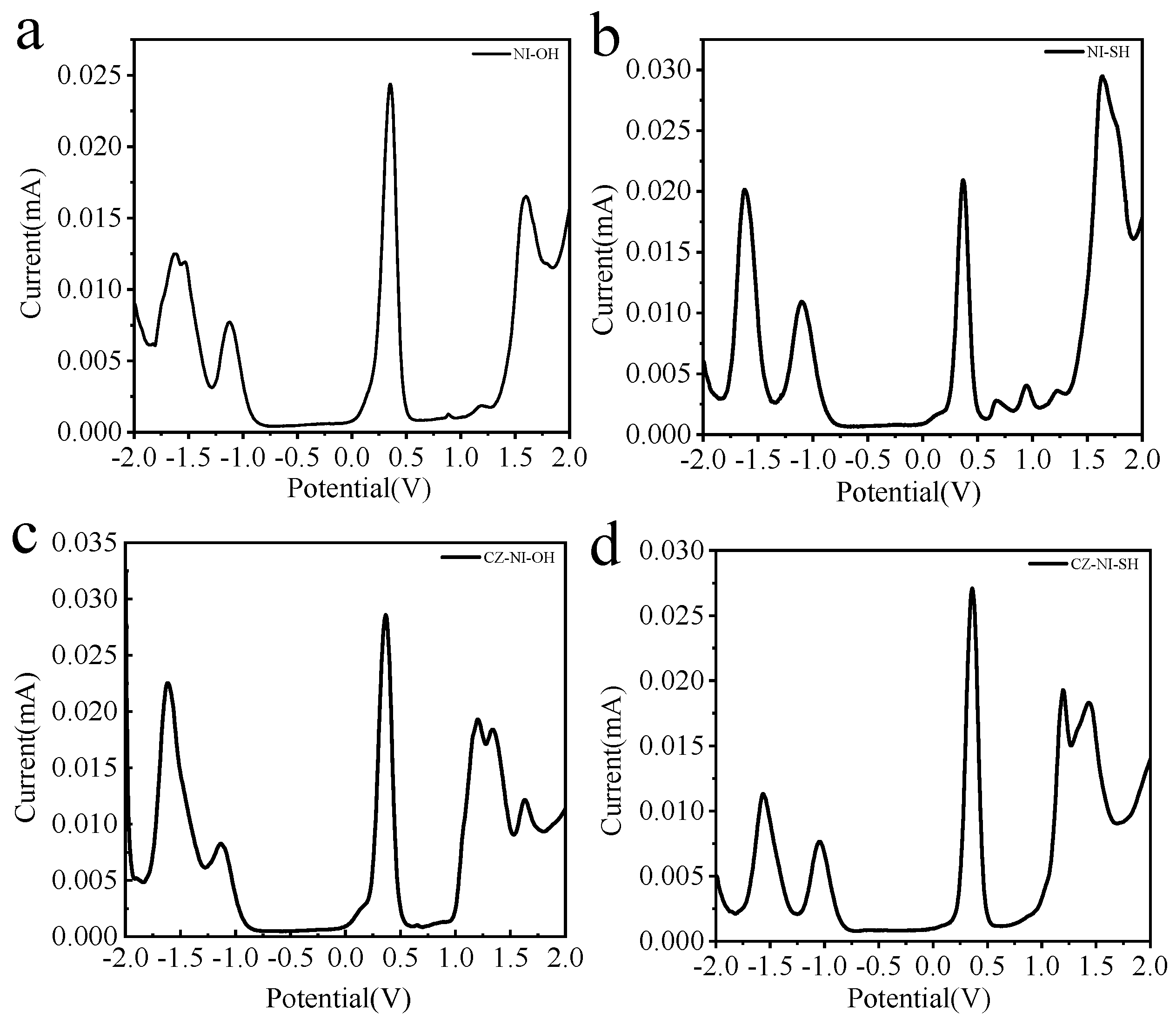

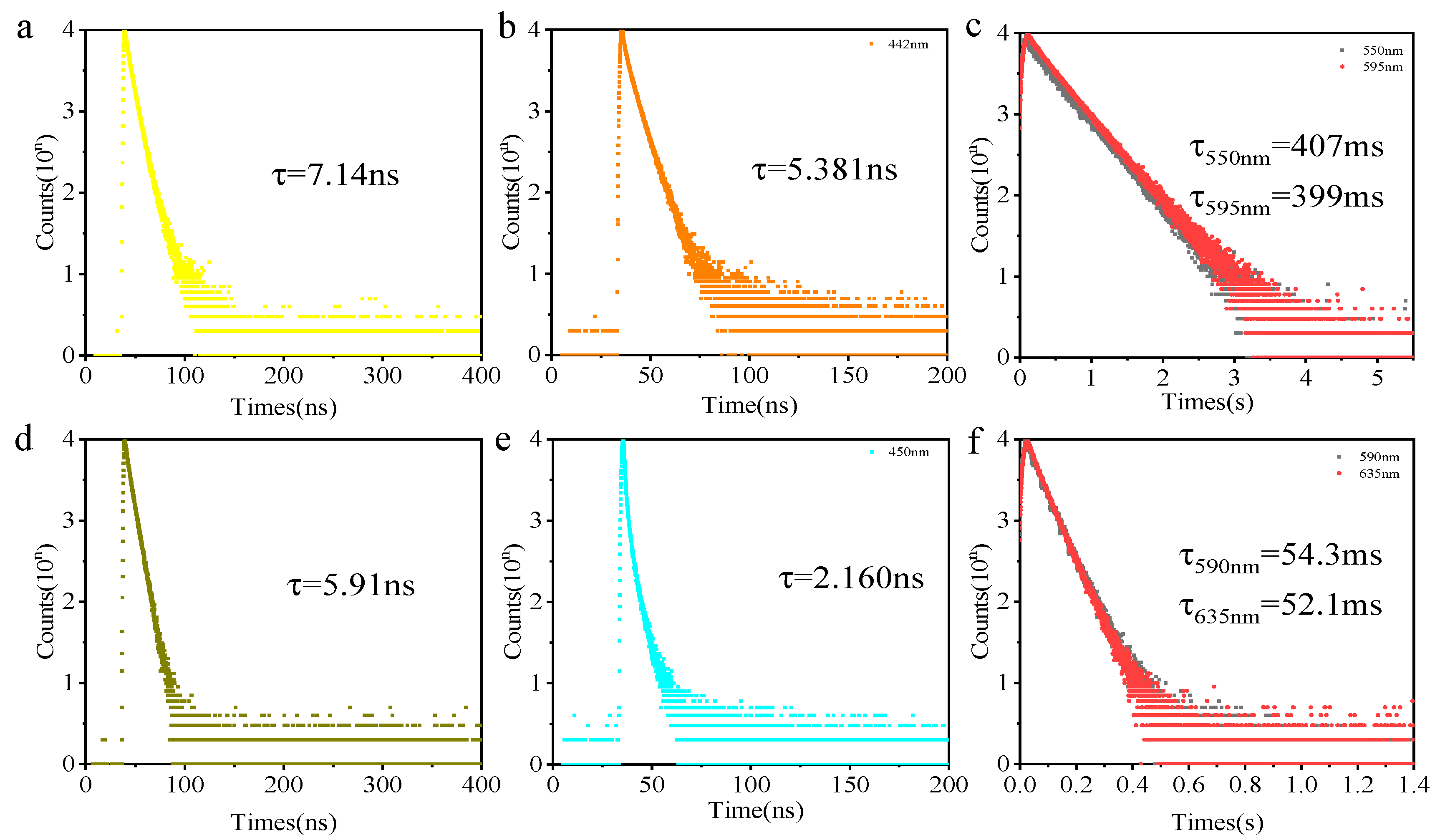
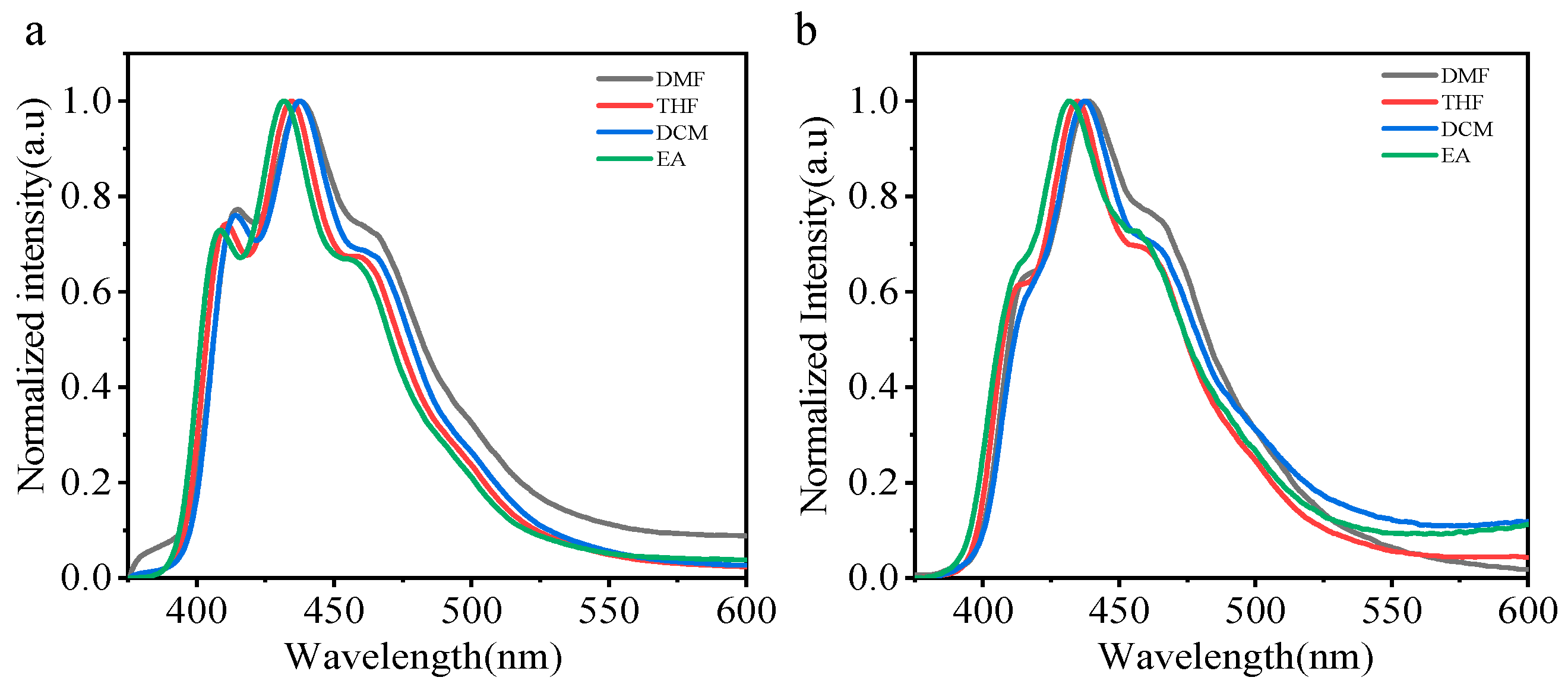
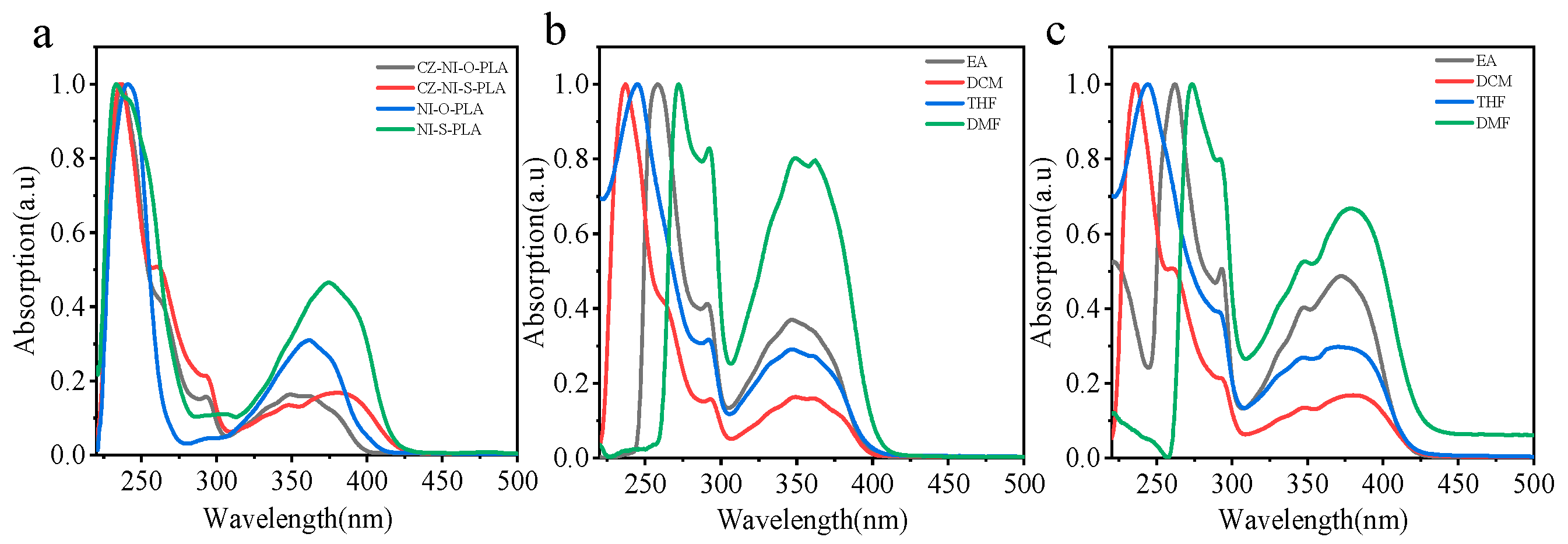

| Entry | Mn | Mw/Mn |
|---|---|---|
| CZ-NI-O-PLA | 14,800 | 1.62 |
| CZ-NI-S-PLA | 13,100 | 1.56 |
| NI-O-PLA | 10,100 | 1.54 |
| NI-S-PLA | 13,600 | 1.47 |
© 2020 by the authors. Licensee MDPI, Basel, Switzerland. This article is an open access article distributed under the terms and conditions of the Creative Commons Attribution (CC BY) license (http://creativecommons.org/licenses/by/4.0/).
Share and Cite
Li, Z.; Zhang, X. Research on Long-Lived Room-Temperature Phosphorescence of Carbazole-Naphthalimide Polylactides. Polymers 2020, 12, 790. https://doi.org/10.3390/polym12040790
Li Z, Zhang X. Research on Long-Lived Room-Temperature Phosphorescence of Carbazole-Naphthalimide Polylactides. Polymers. 2020; 12(4):790. https://doi.org/10.3390/polym12040790
Chicago/Turabian StyleLi, Zhiwei, and Xingyuan Zhang. 2020. "Research on Long-Lived Room-Temperature Phosphorescence of Carbazole-Naphthalimide Polylactides" Polymers 12, no. 4: 790. https://doi.org/10.3390/polym12040790
APA StyleLi, Z., & Zhang, X. (2020). Research on Long-Lived Room-Temperature Phosphorescence of Carbazole-Naphthalimide Polylactides. Polymers, 12(4), 790. https://doi.org/10.3390/polym12040790





